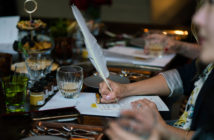With a strong, savory, smoky flavor, this tea isn’t your grandmother’s Earl Grey.
Also known as: Often referred to as “smoked tea.”
Origin: Wuyi region of the Chinese province of Fujian. From Lapu mountain (Cantonese: làaipóusàan síujúng)
Type: Chinese black tea
Appearance: The prepared tea leaves of Lapsang Souchong are twisted and have a rich, dark color. The leaves may have a golden tip. When the tea leaves are steeped, the water turns a stunning red color.
Taste: Lapsang Souchong’s flavor is strong and smoky, similar to the smell of a barbecue or campfire. Lapsang leaves are traditionally smoke-dried over pine wood fires. The tea often has hints of pine, cypress or oak, attributed to the drying process. Early steeps of the best Lapsang Souchongs reveal the taste of dried longan.
Aroma: Permeated with pine, oak or cypress, depending on what wood was used to smoke the leaves during the production process.c
Origin: Lapsang Souchong is a member of the Wuyi family of teas. The story goes that the tea was created during the Qing era when the passage of armies delayed the annual drying of the tea leaves in the Wuyi hills. Eager to satisfy demand, the tea producers sped up the drying process by having their workers dry the tea leaves over fires made from local pines. Lapsang Souchong from Wuyi is becoming more expensive, as the growing area is small and interest is increasing. Tea connoisseurs often note that Formosan lapsang souchong typically has a stronger aroma, the most extreme being tarry souchong (smoked, as the name implies, over burning pine tar).
Steeping Tips: Add 1 to 2 tsp. of loose tea leaves for every 5 oz. of water. Pour boiling water over and steep this mixture for 1 minute, or 3 minutes (see below). Add milk and sugar to taste. This tea is best served hot.
Steeping Suggestions: Leaf Quantity: 2.25 g/cup; Water Temp: 212º (boiling); Steep Time: For a lighter brew, steep only for 1 minute. Many though, prefer it brewed thick and robust – if so, go for up to 3 minutes.
Teaware: Using porcelain tea pots and cups is recommended to prepare this tea.
Trivia: In American author James A. Michener’s 1974 historical novel Centennial, Rocky Mountain fur trapper Alexander McKeag describes Lapsang Souchong as “a man’s tea, deep and subtle and blended in some rugged place…better even than whisky.”
Try:
- Lapsang Souchong Imperial, by Upton Tea Imports
- China Lapsang Souchaong, by Mark T. Wendell Tea Company
- Lapsang Souchong Black Full-Leaf, by The Republic of Tea
- Organic Lapsang Souchong Black Tea, by Arbor Teas
- Traditional Lapsang Souchong, by Taylors of Harrogate




